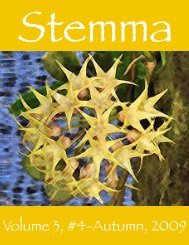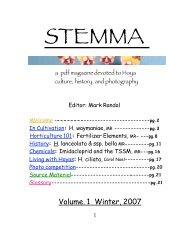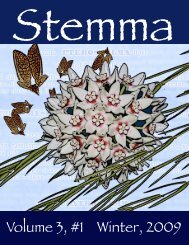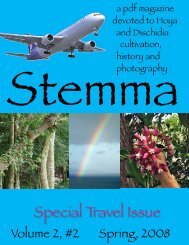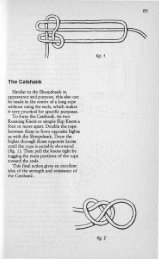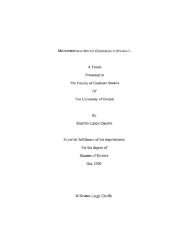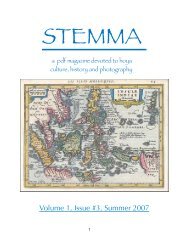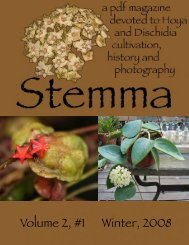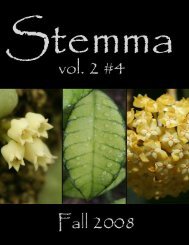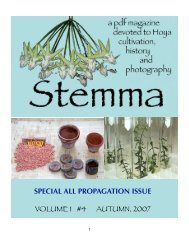Volume 3, Issue #2 - Cubits
Volume 3, Issue #2 - Cubits
Volume 3, Issue #2 - Cubits
Create successful ePaper yourself
Turn your PDF publications into a flip-book with our unique Google optimized e-Paper software.
24: Section Centrostemma (Decne.) Bentham & Hook. f.<br />
Etymology: “centron” = “a sharp point”, Gr. + “stemma” = “crown”, Gr.<br />
Type species: Hoya multiflora Blume<br />
Overall form: these species are bushy, non-twining, mostly terrestrial plants with conspicuous large clusters of<br />
white, pointed, reflexed flowers sometimes tinged with pink, yellow or green. Flowers are mostly not strongly fragrant.<br />
Even small plants in this taxon seem to flower readily.<br />
Distribution: Thailand, Malaysia, western Indonesia.<br />
Publication: (as a genus) Decaisne, A. 1838. Annales des Sciences Naturelles; Botanique 9 (2): 271; (as<br />
a section) Bentham, G. & Hooker. J. D. 1876. Genera Plantarum 2: 776--777<br />
Original description: (as a genus) (translated from Latin by Dale Kloppenburg) “Calyx pentamerous. Corolla<br />
deeply divided into 5 reflexed lobes, with a prominent beard about the base of the gynostegium. Corona of 5<br />
stamens, attached at the upper part of the elongated gynostegium; corona segments fleshy, upright, depressed<br />
above, with the lower margins inrolled, at the base prolonged into a spreading or horn-like spur, at the apex<br />
narrowed into a tooth longer than the stigma. With the terminal membrane of the anther oppressed to the<br />
stigma. Pollinia affixed at the base, erect, oblong, compressed, here with a sub transparent margin. Stigma<br />
apiculate. Follicles single, elongate, cylindrical, smooth. Seed hairy-tufted. ---The climbing plant growing in<br />
the Indian Archipelago, the Moluccas and the Philippines with leaves opposite, leathery, somewhat veined,<br />
glabrous; with the many flowered umbels pedunculate between the petioles and terminal. With flowers often<br />
rather large, yellowish.”<br />
Revised descriptions: Bentham & Hooker. f. (1876), (as a section) (translated [poorly] from Latin by MR)<br />
“Corolla lobes narrow, staminal tube usually longer and interior angle of corona scale long, produced; these<br />
characters notwithstanding these (few or one) species are by no means a separate genus. Species from Silhet,<br />
corolla lobe equally narrow and scale-like, inside long produced...”<br />
Salient features:<br />
Pollinarium- the pollinia are proportionally longer and narrower than those of the vast majority of Hoya<br />
species. The translators are narrow. The corpuscula are relatively very narrow and small.<br />
Corona- the inner corona lobe apex is raised high above the anther membranes, the outer apex is lowered.<br />
The base of the corona is modified into a tall staminal column. This structure is also found in genus Eriostemma,<br />
but in that genus the column is proportionally much broader than in Centrostemma species.<br />
Corolla- lobes are sharply reflexed, margins are revolute.<br />
Raceme- loosely convex.<br />
Species thought to belong in this section/complex:<br />
Hoya multiflora Blume (type) Hoya javanica Boerl. H. sp. Cyrtoceras floribundum Maund<br />
Taxonomic considerations: The names Centrostemma and Cyrtoceras were published as genera in the same<br />
year, 1838. The publication of the name Centrostemma preceded that of the name Cyrtoceras by several months<br />
(Kloppenburg, 1994), so the name Centrostemma has priority.<br />
Genus Cyrtoceras was absorbed into genus Hoya by Bentham & Hooker f. (1876), with Centrostemma as a synonym.<br />
The name Centrostemma has priority, so it is not clear at this time whether this publication would serve to<br />
validly publish the name Centrostemma. If not, the 1994 work “Hoya Sections” by D. Kloppenburg should serve<br />
to validly re-rank the name Centrostemma. In the latter case, the citation would be changed to Centrostemma<br />
(Decne.) D. Kloppenburg.<br />
This taxon seems to be composed of several species, but more work is needed to define the boundaries of<br />
these taxa.<br />
18



